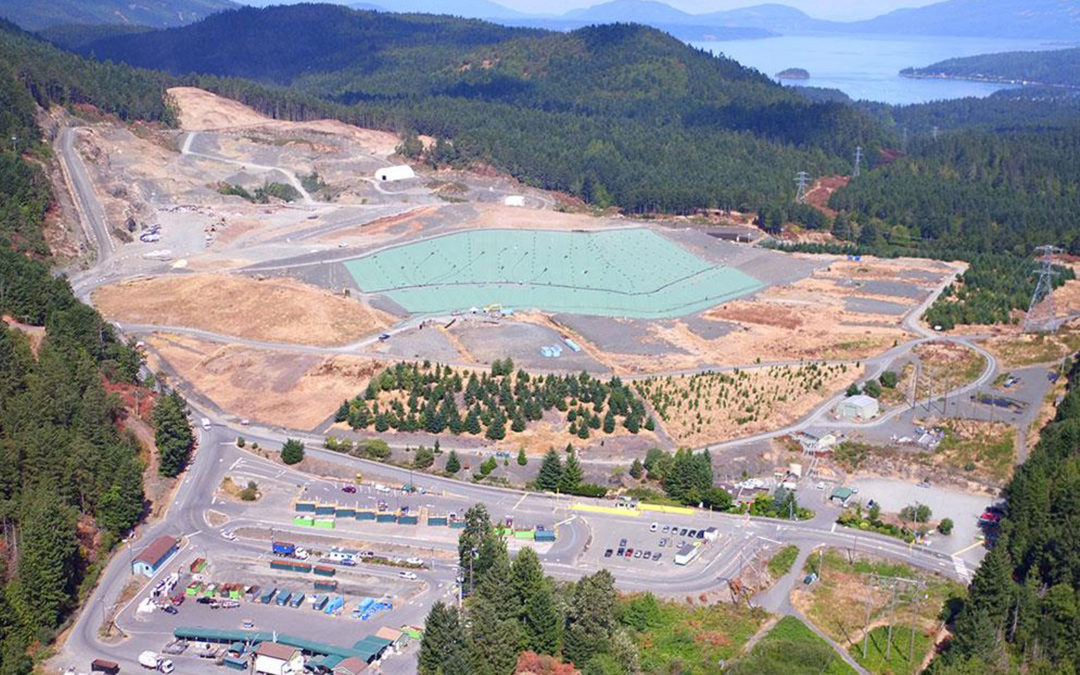After full commissioning of the Residuals Treatment Facility for the Capital Region’s Liquid Waste located at Hartland Landfill, the CRD has confirmed the Facility is now producing bio-solids from dewatered sewage sludge, and is spreading them at the Landfill. The sludge undergoes primary treatment at the Primary Treatment Facility at McLoughlin Point in Esquimalt and is then piped through an 18 kilometre pipeline to Hartland Landfill where the sludge is further treated.
The treatment process involves anaerobic digestion where microorganisms digest the residual solids at approximately 37°C over a period of 15 days followed by a drying process. The fluidized bed dryer further treats the residual solids at a ‘cooking temperature’ of approximately 220°C for over two hours, to produce dried Class ‘A’ biosolids. While Class ‘A” biosolids are treated to remove fecal coliform and heavy metals in accordance with the OMRR (Organic Matter Recycling Regulations), the provincial standard does not measure for many other contaminants such as dioxins, organic contaminants that can release staphylococcus aureus (superbugs) and what are known as “persistent organic pollutants (POPs) and “contaminants of emerging concern (CECs). The BC Ministry of the Environment has documented the numerous toxic elements not tested for under the OMRR in a recent study:
https://www2.gov.bc.ca/assets/gov/environment/waste-management/organicwaste/biosolids/biosolids_sa
Numerous studies have identified risks to human, plant and animal health from air and waterborne biosolids. More information can be found on the Coalition’s
website: https://www.mountworkcoaliRon.org/be-informed/five-reasons-crd-spreadingtoxic-biosolids-is-a-bad-idea
In 2013, the CRD banned the spreading of biosolids but reversed this ban in 2020 on short notice when it was learned that the Lafarge brick kiln in the Lower Mainland, the facility to which the biosolids are to be shipped, is closed for 6-8 weeks per year for maintenance. The Lafarge Plant is currently closed due to ongoing safety issues.
The CRD has said that the spreading of biosolids at Hartland is a temporary solution, but there is no plan to recover the biosolids from the soil once spread. The Mount Work Coalition opposes the spreading of biosolids at Hartland because of the danger of doing so in proximity to nearby lakes, streams, farms, schools, species at risk, recreational areas and residences.
FOR FURTHER INFORMATION CONTACT:
HUGH STEPHENS, VICE CHAIR, MOUNT WORK COALITION AT 250 813 0339

Yet another reason why the Greater Victoria Municipalities should amalgamate. There is no political accountability for the CRD members. I live in Victoria, next election I would like to vote for someone who opposes Colin Plant ( sannich councilor crd member who voted for this sludge spreading), but I can’t because I live in a different fiefdom.
As reported in times colonist dated Feb 2020 , which just refers to spreading 700 of the 7000 tons per year. Presumably we are now(march 2021) spreading at a rate of 580 tons a month, with no end date in sight and no alternative plan.
“Saanich Coun. Colin Plant, who chairs the CRD board, said Wednesday that the district is operating under “very tight timelines” to submit a plan to the province by the end of April.
He said that he and a majority of directors are confident that spreading the material at the dump for a short period of time poses no health hazard.
“We will be going out to talk to the community,” he said. “But if I felt in my heart that there was danger to the water and to the welfare of the people of Willis Point, I would not have voted for this.”
Plant added that the board has a “high level of confidence” in the level of treatment that the biosolids will undergo to render any contaminants inert, “such that when we are finished, we will have a product that actually exceeds provincial requirements.”
It is really ridiculous that this stuff has to be trucked all the way over on the ferry to the lower mainland , with all the emissions that entails, then be burned. There must be places on the island that can be used as sanitary dumps?